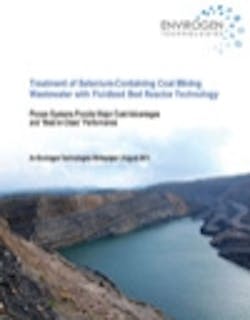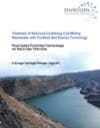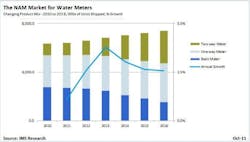State Control, Private Enterprise – N'er the 'twain shall meet?
By Andrew Walker
Pacific Institute/CERES Report
Recently, global water and financial leaders convened in Switzerland to find ways that enable investors to participate in the safer haven the water sector represents, facilitating more capital to flow into it. Rather than encourage a bipolar development of one area with substantial private involvement, and another without, participants at the "Blue, Green & Gold: Where Water Meets Money" conference advocated a mesh of public and private partnership. The Global Water Intelligence/International Desalination Association event was held April 27-28 in Zurich.
Realpolitick of Water
Like it or not, water is rapidly moving to the centre of people's attention – and not only in terms of a safe drinking water supply and good sanitation. A February 2009 report by the Pacific Institute for Ceres – a U.S. coalition of investors, environmental groups and other public interest organizations – stresses water scarcity and climate change risks to business as a whole are, at best, poorly understood. Ceres advocates a full assessment of these as integral to every corporation's financial reporting, citing investors' heightened concerns about exposure due to water supply uncertainties. Sectors exposed in particular, the report says, are the food, beverage, oil and chemical industries. Figure 1 shows an increase in shareholder resolutions asking for more disclosure on water practices and performance, including water policies, environmental and social impacts of water use, and water usage throughout the value chain. Ceres described three major points of shareholders concern:
- Physical risks: water supply quantity and quality; the risk of power shortages due to water scarcity ("the water and energy collision")
- Reputational risks: community opposition; clashes due to over-allocation of access rights; and outright conflict
- Regulatory risks: increase and unpredictable cost of water; cost of water disputes and litigation
The report finds:
- Risks within the supply chain go far beyond the actual water footprint.
- Competition with the local population for water rights is increasing.
- Wastewater discharge poses an increased risk (grey water footprint).
- Public scrutiny of corporate water practices is growing.
It concludes: "Companies that treat pressing water risks as a key strategic challenge will be far better positioned in the future. Companies that continue to ignore these challenges put themselves at higher risk."
Closing the Gap
Some see this increased sensitivity as a chance for structural reform in the water sector – to break from a legacy of under-finance and inefficiency. Having mainstream attention could be a blessing: Will the investment gap be closed? Can the sector more easily attract quality water professionals? Will the supposed burden on governments to provide "cheap" water be lessened? Will system inefficiencies like water loss and poor services from aging infrastructure ever be a thing of the past? But some also are quick to highlight a potential downside: Will water service providers be more subject to stock market whims? Will the sector be inundated by shady dealers (see the latest James Bond film yet?). Will the developing world be left even further behind? Nobody is saying the private sector alone is the silver bullet, and many are concerned about risks of putting resource No. 1 into its hands entirely. But it's often overlooked that there's a wide range of different public-private partnership (PPP) models that can be applied. The Organisation for Economic Co-operation & Development (OECD) advocates a case-by-case determination of the degree of private and public participation in water projects and services. It describes different models on its website (see Table 1).
Enterprise Drives Innovation
"Without the private sector, the torrent of innovation in the sector would be a trickle," noted one presenter in a purposely provocative "public vs. private" debate at the Zurich conference. His counterpart tried to highlight "greed and waste" financial incentives produce but, on the innovation front at least, the consensus was clearly in favour of private enterprise as the driving force in unleashing innovative creativity.
With Singapore International Water Week just past, take the example of the Singapore Innovative Technology Challenge. The government issued a request for proposals in August 2007 to produce WHO standard water from seawater at 1.5 kWh/m3 or less. Six proposals made the finals, and Siemens convinced the jury its was best: a synthesis of electrodialysis (ED) and continuous electrodeionization (CEDI), two methods currently practically unused for desalination.
According to Tim LeTourneau, director of Siemens' Global Desalination Program (based at its Singapore R&D centre), "This novel technology for desalination will break through current barriers of physical limitation." The three-year project, financed 50/50 by Siemens and the Singapore Environment & Water Industry (EWI) Development Council, aims to cut energy consumption by +50% compared to current best-available technology, translating to a 35% reduction in overall operating costs. It's scheduled to have a 50 m³/day demonstration unit operating in September 2011 followed by a two-year commercialisation period.
With innovation in mind, the conference hosts organised a "Water Technology Idol" competition – mimicking the American Idol TV program – where owners of various innovations presented their case and the audience voted. The six finalists were:
• Offshore membrane desalination driven by deep sea pressure differences – www.dxvwater.com
• Use of forward osmosis to extract freshwater from seawater – www.oasyswater.com
• Non-fouling MBR water reuse developed at the University of Illinois – www.watercampus.com
• Natural water extraction using Aquaporin proteins that regulate flow of water in cells – www.aquaporin.dk
• Particularly memorable was Tom Davis, a research professor at the University of South Carolina, who accompanied his techy-slideshow with a ballad sung to his zero liquid discharge technology for reusing brackish water, the rights to which were acquired from ZDD Inc. by Veolia in June
• The winner, judged by a panel of technologists and economists, was Mark Tonkin, who presented a system for irrigating the desert with seawater via a novel, and secretive, plastic material through which the plant's roots can draw their exact water needs without evaporation loss – www.dti-r.co.uk
Investor Criteria
With many investors seeking calmer waters, conditions most conducive to attracting capital were summarised as follows:
- Smart, sustainable water systems that eliminate inefficiencies.
- Holistic view, incorporating the magic triangle of water, energy and food.
- Bite-size projects with a shorter time scale.
- Innovation with reasonable commercialisation times and penetration rates.
- Stable political conditions or guarantor.
- Mature projects that demonstrate a viable and feasible structure.
There was a firm statement that, while capital isn't as easy or cheap to come by as yesteryear, there are no significant limitations to investment in solid areas like the water sector.
Individual Perspectives
Ravi Suri of the Standard Chartered Bank's Dubai office dispelled some myths about project finance, describing the current realignment as healthy. In his analysis: 1) Risk is being spread better among project partners; 2) Project finance may be more expensive but interest rates have come down, so overall costs aren't up, and 3) Commercial banks haven't fully withdrawn, and as the dust settles, they'll step forward with investment schemes more thoroughly controlled and seeking less risk – e.g., what water solutions have to offer.
Helge Daebel of Zurich venture capital firm Emerald Technology Ventures said, big and growing markets, scalable and sustainable business models, and top quality management are key to securing such funds. The global technology push in the water sector is largely at an early stage, enabling investors to profit from growth right from the beginning. He showed a matrix for systematic assessment of investment opportunities, of which he sifts through hundreds per year. While the water sector generally offers stability, the time to penetrate the market cripples venture capital's desire to invest. In 2009's first quarter, his firm closed on three of about 50 deals vetted.
Gore on Water, Energy
A highlight of the Zurich proceedings was the GWI Global Water Awards ceremony, with Nobel Peace Prize winner and former U.S. Vice President Al Gore. In his dinner speech, he spoke about how climate change is affecting water supplies and societies in different parts of the world. He described how closely energy and water are interlinked, and appealed to water professionals to join forces with the energy sector in pressing common goals, rather than competing for public attention. Finally, he congratulated the award winners (see www.globalwaterawards.com) and presented them with trophies.
Conclusion
The conference showed more successful examples of well-running water services arose where the public, private and voluntary sectors combined individual strengths to make the sum greater than the whole. Coming back to the "twain," we quote the realpolitik author Mark Twain, aka Samuel Clemens: "Whiskey is for drinking; water is for fighting over." By harnessing the increased impetus and public interest to solve water challenges, each and every party fighting on the same side would seem the sensible choice.
Author's Note: After global communication management posts at Siemens and the International Water Association, Andrew Walker advises and supports water organisations and corporations as an independent marketing consultant: [email protected]
More Water & WasteWater International Issue Articles
More Water & WasteWater International Archived Issue Articles



